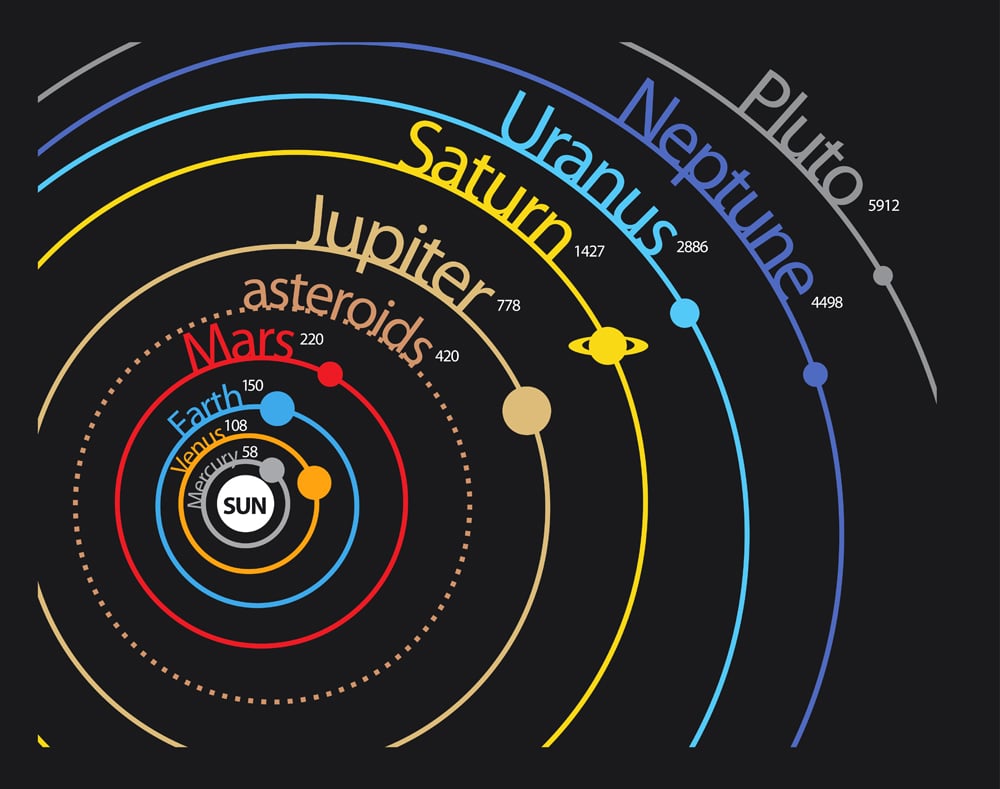How do objects in space travel? |
- The geocentric model states that the Sun and the planets move around the Earth instead of the heliocentric model with the Sun in the center. That's just silly, right? Obviously the Earth orbits the.
- By selecting the option 'Mark perihelion / aphelion', labels can be added which mark the closest and further points from the Sun along the orbits of each of the planets. The Earth's orbit is additionally labelled with the points it passes on the first day of each month as it makes its annual circuit around the Sun.
Size and Distance. With a radius of 432,168.6 miles (695,508 kilometers), our Sun is not an especially large star—many are several times bigger—but it.
What are the orbital lengths and distances of objects in our solar system?
Space is huge, and even our immediate environment is gigantic. We are the third planet from the Sun, and the third of three inner planets, all of which are right next to the Sun compared to others. The picture below shows the planets in their orbits on the orbital plane. You have to look carefully to see our home. The four inner planets (Mercury, Venus, Earth and Mars) are in the tiny disk in the center, inside of Jupiter's orbit.
Image from The Nine Planets, a Multimedia tour of the Solar System by Bill Arnett http://seds.lpl.arizona.edu/nineplanets/nineplanets/nineplanets.html
The planets are far from the Sun, travel huge distances in space, and take a long time to do so. Pluto takes almost 250 years to go around the Sun completely and travels almost 23 billion miles to do so!

| OBJECT | Distance from Sun (average) | Distance traveled in one complete orbit of the Sun (one 'year.') | Amount of time for one complete orbit of the Sun (one 'year.') |
| Sun | 0 miles | ||
| Mercury | 36,800,000 miles | 223,700,000 miles | 3 Earth months |
| Venus | 67,200,000 miles | 422,500,000 miles | 7 Earth months |
| Earth | 93,000,000 miles | 584,000,000 miles | 1 Earth year (365.25 days) |
| Mars | 141,600,000 miles | 888,000,000 miles | 23 Earth months. Almost 2 Earth years. |
| Jupiter | 483,600,000 miles | 3,037,000,000 miles | 142 Earth months. Almost 12 Earth years. |
| Saturn | 886,500,000 miles | 5,565,900,000 miles | 354 Earth months. (29.5 Earth years) |
| Uranus | 1,783,700,000 miles | 11,201,300,000 miles | 1009 Earth months. (84 Earth years) |
| Neptune | 2,795,200,000 miles | 17,562,300,000 miles | 1979 Earth months (almost 165 Earth years) |
| Pluto | 3,670,100,000 miles | 22,698,700,000 miles | 2977 Earth months (248 Earth years) |
The distance from the Sun is average because the orbits of the planets do not make perfect circles, but rather very slightly flattened ones, or ellipses.
What causes an orbit to happen?
What is an orbit?
How do scientists know what the path of an object in space will be?
What is a satellite?
What are planets made of?
How do asteroids orbit?
How is an ellipse different from a circle?
Are there orbits within orbits?
What is the orbital plane?
How do we know what's in space?
How do spacecraft use an orbit to move from planet to planet?
Question: Which planet in our solar system is orbiting the sun at the fastest speed? — Mike
Answer: Mercury is the winner at an orbital speed of about 47.87 km/s (107,082 miles per hour), which is a period of about 87.97 Earth days. Just for your information, here is a list of the orbital speeds (and periods) for all 8 (plus Pluto) planets:
- Mercury: 47.87 km/s (107,082 miles per hour), or a period of about 87.97 days
- Venus: 35.02 km/s (78,337 miles per hour), or a period of about 224.7 days
- Earth: 29.78 km/s (66,615 miles per hour), or a period of about 365.256365 days
- Mars: 24.077 km/s (53,853 miles per hour), or a period of about 686.93 days
- Jupiter: 13.07 km/s (29,236 miles per hour), or a period of about 11.86 years
- Saturn: 9.69 km/s (21,675 miles per hour), or a period of about 29.42 years
- Uranus: 6.81 km/s (15,233 miles per hour), or a period of about 83.75 years
- Neptune: 5.43 km/s (12,146 miles per hour), or a period of about 163.72 years
- Pluto: 4.74 km/s (10,603 miles per hour), or a period of about 247.92 years
Planets Orbit The Sun Like The Moon
Jeff Mangum
